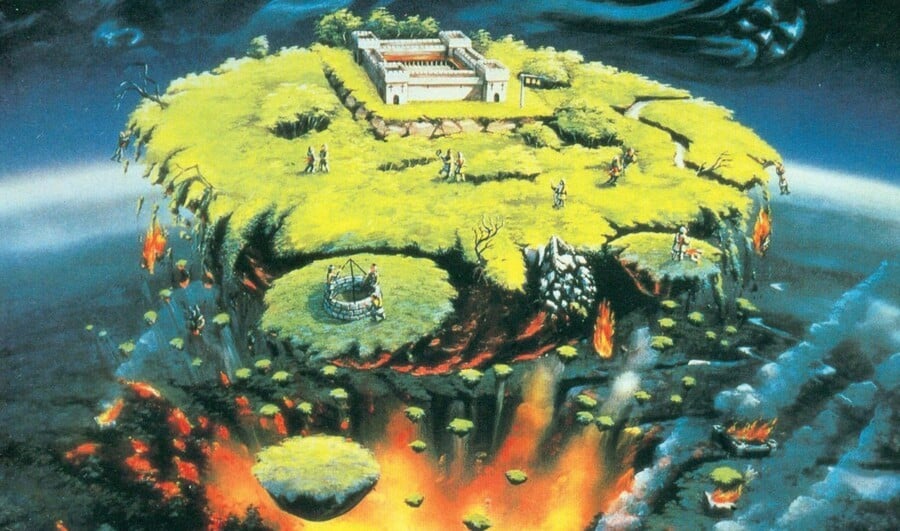
When the Super Famicom hit Japanese store shelves at the end of 1990, it was accompanied by a host of particularly strong titles that did a superb job of communicating the power and versatility of Nintendo's new platform: Super Mario World, F-Zero, Pilotwings, Final Fight; these were arguably system-sellers that could walk effortlessly into any console launch lineup, but there was another title which, to some, may have seemed like the odd one out. Granted, Bullfrog's Populous had already become a critical and commercial smash hit in Europe and North America on the Amiga a year earlier, but how had a strategy game which was apparently so focused on western sensibilities managed to sneak its way into the Super Famicom's fledgling software library, a library which comprised almost entirely of Japanese-made action or adventure titles?
To get the full story of how this remarkable and groundbreaking game gripped Japan, it helps to get right back to the beginning and investigate its genesis. "It really all started with a person who I worked with at Bullfrog called Glenn Corpes, who had drawn some isometric blocks on screen," recalls the one and only Peter Molyneux OBE, the game's designer. Instantly gripped by the tantalising potential of the premise, Molyneux asked if he could play around with it. "I mocked-up this prototype where there was a landscape of isometric blocks and then I thought, what should I put on that landscape? I thought it would be fun to have little people." And thus, a legend was born.
"Glenn and I connected together our two machines using an RS-232 cable, and we used to play the game," continues Molyneux. "Basically, if Glenn ever won at all, I used to think that that was proof that the game wasn’t ready to ship, so I would change things so I would continue to win," he chuckles. Molyneux and Corpes had found the hook of Populous – competitive play, not just against the AI, but a human player as well – and eventually introduced elements such as terrain deformation, combat, buildings and natural disasters, the latter of which a player could use to thwart the progress of their opponent. The team knew they had something special on their hands, but convincing a publisher of the title's merit was significantly harder; several companies were approached (including the Danish toy firm Lego, primarily because the team had conceptualized levels using real-life Lego blocks), all of which rejected the concept until industry giant Electronic Arts agreed to take Populous on.
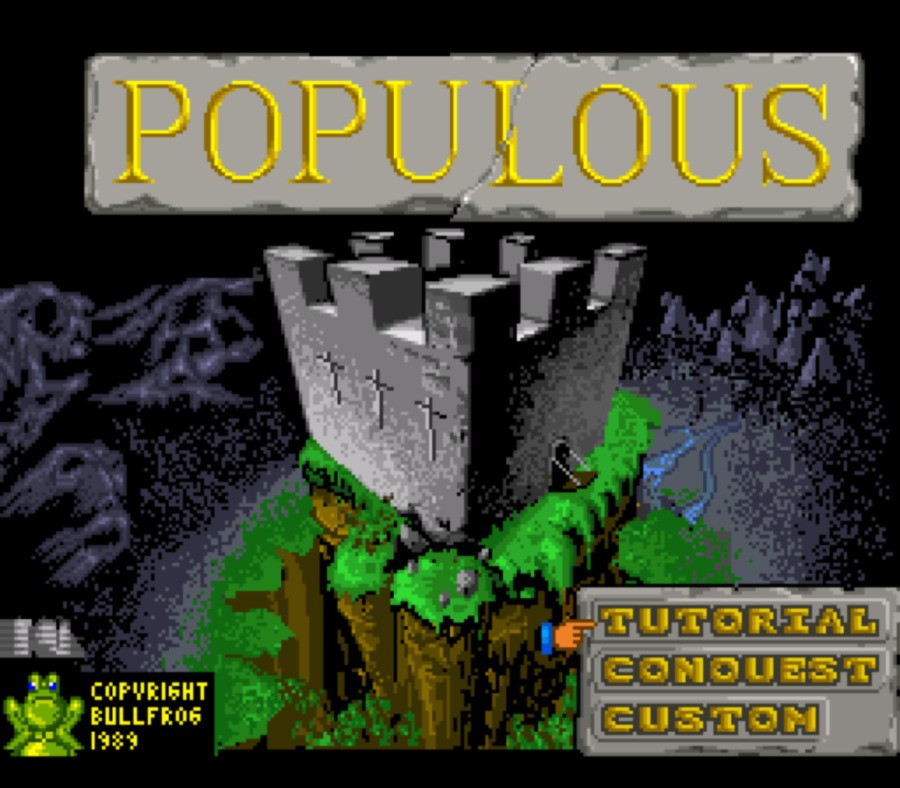
"Then this 'plaything' started to become real," recalls Molyneux. "We finished the game – I think in total it took around nine months with the two of us, Glenn doing the graphics, and me doing the game – and then it was launched. It was so different in those days because I think it only had two days’ worth of testing before it was shipped. The game had 500 randomly-generated levels, and the testing guy asked, 'How do we get to the end of the game, so we don’t have to play all the levels?' And that’s when I realised that we hadn’t actually done an 'end', so we had to quickly mock one up, which was incredibly underwhelming."
Populous sold millions of copies on home computers and is credited with siring the 'God Sim' genre – although Molyneux says creating new game categories was never an objective. "We had no idea what we were making at the time. There was an evil God and a good God and that was it; we didn’t make the connection. It was more the journalists who made the genre rather than us." Nonetheless, the game's impact on Molyneux's circumstances was transformative. "My life at that time was one of incredible debt and complete and utter obscurity," he admits. "I had never really spoken to anyone in the press before, the company was not really making enough money even to pay Glenn let alone me, so when Electronic Arts came along after shipping the game and said, 'Congratulations, you’re now rich!', it was unbelievable; over the course of six weeks it changed the whole course of my life, and without Populous I’m sure my life would have been 100 percent different. It was a real rags to riches story."
At the time, the home computer gaming market – dominated by the Atari ST and Amiga, but also including the PC and Apple Mac – was under increasing threat from a new wave of specialised and powerful Japanese games consoles, and the best computer games were being earmarked for conversion by publishers keen to meet the demands of this rapidly-expanding potential audience. Populous was, on paper, an obvious candidate. "There were a bewildering number of versions," recounts Molyneux. "I think at that time some of them were handled by Electronic Arts, some were handled by us internally and some were handled by other publishers. Because the money from Populous allowed us to expand a little bit, we decided not to do the conversions in-house, because we didn’t know much about things like the Mega Drive and the Super Famicom and we didn’t have a licence, so what tended to happen is you’d get approached by a publisher and they would handle the conversion."
Back in the early '90s, the whole process of meeting with potential publishers and business partners was rather more haphazard than it is today, what with things like GDC and the internet existing – as Molyneux's next anecdote attests. "Populous had been released and it had been on the market for about two or three weeks, but had shot to the top of the charts in Europe, the UK and in the US," he says. "We got a phone call one day from this Personal Assistant and she said the President of this massive billion-dollar Japanese corporation – the parent company of Japanese publisher Imagineer – would like to come and see us this afternoon."
It was the dream ticket, a gateway to further riches; the deal with Electronic Arts was life-changing, but didn't give the US publisher rights to everything. Bullfrog was free to negotiate with other parties when it came to territories in which EA didn't operate, and the Japanese market represented a significant opportunity. However, there was one slight issue: Bullfrog's office was only an office in the loosest sense of the word.
"It was in a tiny room above an old age pensioner – you had to actually walk up through her flat to get to us on the top floor," recounts Molyneux. "She had, poor soul, so many ailments; she hadn’t left her flat for ages and she was a little bit confused. So this President of this billion-dollar corporation turned up in this limousine, pressed on the doorbell, started walking upstairs and Cath – the old age pensioner – took one look at him, grabbed her broom and started hitting him and chasing him out! So, they came outside again, phoned us up, and said, ‘We can’t get up your stairs because there’s a strange woman’, so we had to escort them up. It was incredibly embarrassing, and when they got up there, it wasn’t an office – it was just a few desks and sofas and loads of pizza boxes, cans of Coke and enormous ashtrays full of cigarettes; and it must have absolutely stunk because we never cleaned up."
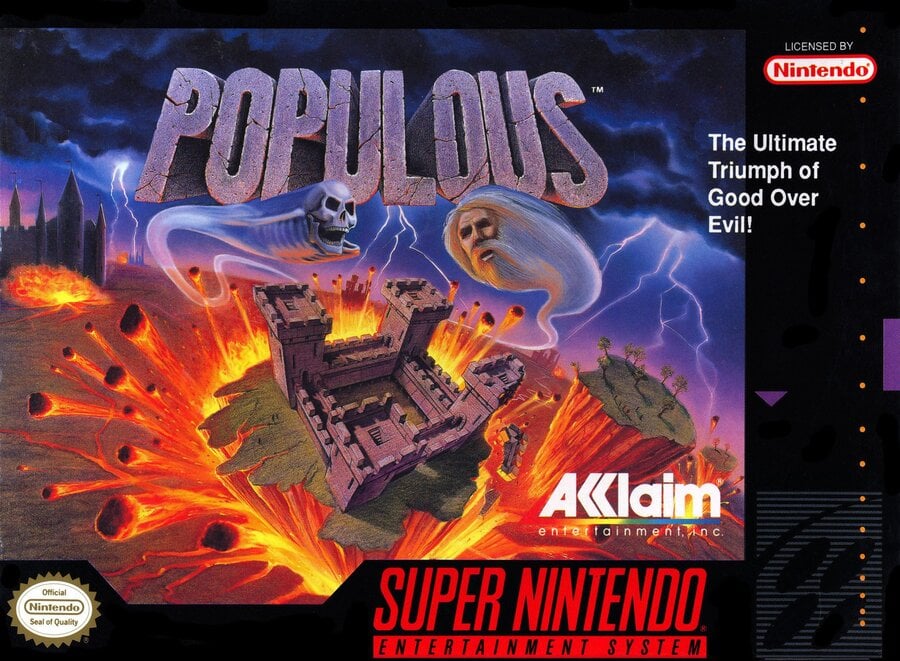
Sitting amongst the smelly fast-food packaging and overflowing ashtrays, the President explained why he had made the considerable journey to the United Kingdom – and unwittingly faced the wrath of a senile old lady – to meet with Bullfrog. "He said, ‘We’d love to talk to you about the publishing rights in Japan’, and I said, as I normally did, ‘Well, that sounds really interesting’, knowing in the back of my mind that maybe now they’ve seen what we’re really like, they’ll probably go away and that will be the end of it," says Molyneux with a self-deprecating smirk.
That was not, as you might have already figured out, the end of it – not by a long chalk. With the deal signed and Imagineer handling the conversion (the company even added a special 'Nintendo World' complete with Game Boy and Famicom consoles, as well as unique Mice and Pig races), Molyneux was asked if he would be willing to fly out to Japan to on a promotional junket to support the launch. "It was astounding," he recalls today. "Me and Les Edgar – who was my business partner at Bullfrog – spent the whole of the flight just drinking pretty much everything that we could and eating everything we could, so I felt violently ill when I got off the flight; a combination of jetlag, multiple hangovers and an enormous amount of food. This was a 12-hour flight, and it was the first time I’d ever travelled in anything other than economy."
If the pair thought they'd have time to unwind the moment they touched down in Japan, they were sorely mistaken. While the Super Famicom version was set to launch alongside the new console, Populous was by no means an unknown quantity in Japan; the home computer edition had already made waves with a gaming public which had also eagerly lapped up the likes of SimCity and was keen to meet the western genius behind the next big world-building strategy import. The airport was packed with crowds and TV cameras; they were being treated like rock stars. "I think this was the first time I ever signed an autograph," says Molyneux. "It was an insane time. Then they dropped us off at the hotel, and said, ‘Right, we’re going to pick you up tomorrow at 9 o’clock’, because it was quite late in the evening then, and said 'Could you do a number of press interviews?' I said yes, but I didn’t really have any experience in the press stuff. They had organised for press interviews to go from 9 AM until 8 PM, half an hour each session, over two days, and it was just absolutely insane." Molyneux had underestimated just how seriously the Japanese took their video gaming.
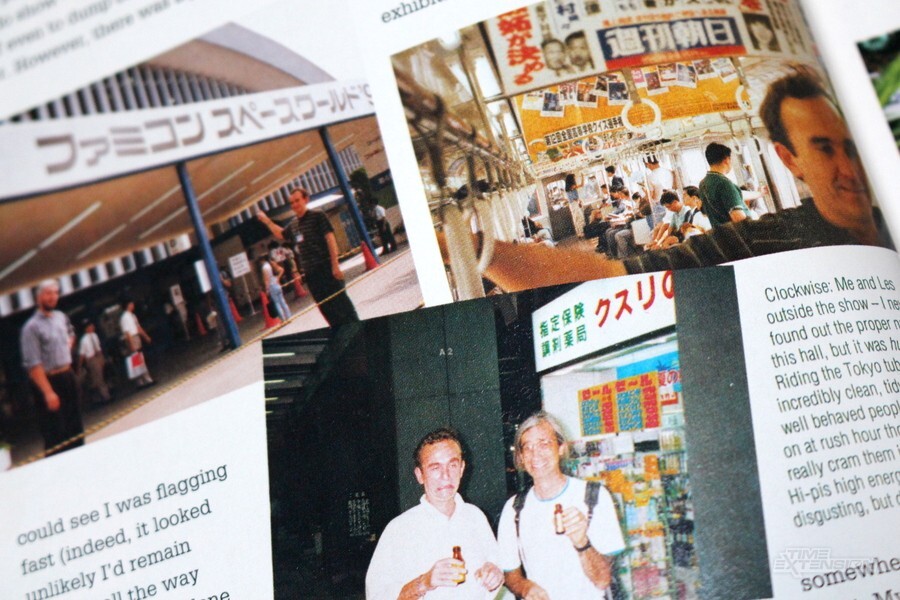
It was the first of many culture shocks for the legendary designer. "Bizarrely, after all that, to say thank you they organised for us to fly out to this resort which the parent company owned on this island resort," adds Molyneux. "This resort was basically for teenage and early 20s women, and we were the only men there! We spent some time there and then they took us on a tour of Tokyo, and that’s when I went to Akihabara for the first time – which was absolutely mind-blowing. It was full of things that you never saw over here. Akihabara has changed now, but back then it had everything from weird spy cameras to electronic toilets to the most bizarre things you could possibly imagine, and that was pretty incredible."
Later on in life, Molyneux would come to appreciate Japan's eccentricities and become deeply affectionate towards the nation, its traditions and – of course – its amazing gadgets. "That’s where I got my first laptop from, the screen was about the size of a credit card," he says. "As time moved on, I had paid back all my debts and I had some spare money, and one of the things I really wanted was a Japanese toilet. I got them to ship back this toilet, and it won DHL’s 'most original shipment of the year', because it had been wrapped it up exactly like a toilet, so you could still see that it was a toilet – it wasn’t in a box, it was just this toilet-looking thing."
But back to 1990. Soaking up Japanese culture was one thing, but Molyneux and Edgar were in the Land of the Rising Sun that year for a very specific reason, and that reason was Populous. With Imagineer handling all of the porting and marketing duties, Molyneux was more of a promotional figurehead; the famous star who had created this must-have video game. He remains shocked at the sheer resource that was thrown at pushing his humble little game to millions of Japanese players. "I may be getting confused here because it was such a long time ago, but I seem to recall they paid for some CG to be done for the Japanese television advert, and it was one of the first times ever that CG had been used in that way," he remembers. "At the time, I looked at it and thought, 'Oh my God, that’s the most incredible thing I’ve ever seen'; it was like a little landscape which you flew over and this volcano exploded. If you look at it now, it probably looks like the most primitive thing ever, but at the time it was gobsmackingly amazing."

As one of the few titles available for the Super Famicom at the close of 1990, Populous was assured plenty of media interest, irrespective of the fact that the game already had a strong following in Japan. However, Molyneux sheepishly admits he didn't take note of its commercial fortunes in that part of the world. "This is another thing you’ve got to remember, back in the day you had to wait for the charts to come out in the magazines. And the problem with the Japanese magazines is they were all in Japanese! Also, the other thing to remember – and this does sound awful, and it is awful – but this thing just had a life of its own. At the time we were so busy doing either PowerMonger or Populous II, or thinking of expanding the company, and we didn’t have time to track how Populous on the Super Famicom was doing in Japan. We didn’t even know how many were being sold in the world. What we were really passionate about was what we would do next, and there wasn’t really time to do any other business stuff. However, we did know that Imagineer was incredibly happy."
Even as he makes this revelation, Molyneux admits that the terms he agreed with Imagineer – like those he agreed with Electronic Arts – were probably not fantastic, so the Japanese company had reason to be cheerful in that respect. "We didn’t have any expertise in doing negotiation at all, so the deals that we signed back then were pretty s**t," he explains. "They were around ten or eleven percent royalties, which was pretty tragic, but even so, that was a lot of money coming in for us. I knew it was successful in Japan because all these events started happening. They had this huge concert with thousands of people and the only thing that was played at this concert was the music and sound effects from Populous, and music inspired by Populous. There were cartoon strips and books and stories; there was a constant stream of signatures needed, so I absolutely knew it was successful."
So successful, in fact, that Molyneux was asked by Imagineer to come to Japan for a second time to take part in another promotional exercise. "They said they'd love to invite me over again to talk to the press about our latest game, which was PowerMonger," he remembers. "They'd also held a national competition to try and find the best Populous player, and as part of that competition, the winner could play the creator of the game – that would be a brilliant finale. I glibly agreed, thinking that it would be in a meeting room somewhere. Instead, when I actually got there, it was in this huge theatre which must have easily sat 2,000 people. It was completely full, and this Japanese bloke came out with an incredibly serious look on his face and wearing one of those Japanese bandanas, and he bowed – he took it all amazingly seriously."
Surely the man who helped craft this amazing game could deal with such pressure? "I hadn’t played Populous for probably about nine months," Molyneux replies, chuckling to himself. "I was developing a new game, so I just hadn’t had the time. I wouldn’t have said I was particularly good at it even with practice, but I felt OK because I knew that there was secret cheat mode available. If I could press this certain key combination and put the mouse into the top-left hand corner of the screen, it would give my game a boost; I thought to myself, 'I could always do that'. But unfortunately, as part of the presentation, the screen showed my face in full, my screen in full, and it had a camera pointing down at my hands to show what they were doing. So I couldn’t activate the cheat!" It's unlikely that Molyneux would have had time to successfully exploit the hack anyway, due to the potency of his Japanese rival. "They’d scheduled this to go on for an hour and it took the bloke three minutes to totally defeat me," he says with a laugh. "It was the most humiliating moment in my life. I felt somewhat scarred after that!"
Still, onwards and upwards. Despite his mauling in Japan, Molyneux was in good standing with Imagineer and the publisher was keen to continue the relationship. Given that the console versions of Populous – and indeed, most other notable ports from this period – were at least a year behind the home computer originals, Imagineer had a good idea of what it could ask Bullfrog for next. Both PowerMonger and Populous II would be published in the region by the company, but Molyneux struggles to recall these events due to the understandably hectic nature of this period of his life.
"I’ll be absolutely honest with you, the whole period is kind of blurred into one kind of crazy, crazy, crazy time," he sighs. "I can remember feeling an enormous amount of pressure to get PowerMonger out, an enormous amount of pressure to get Populous II out – and while that was all going on, I was doing my first real press interviews, and then people realised that I didn’t mind talking to the press and quite enjoyed it, so there was a huge number of those. Then having to do the coding on PowerMonger and Populous II… it was just adrenaline-fuelled craziness. It was 24/7, full-on, all the time."
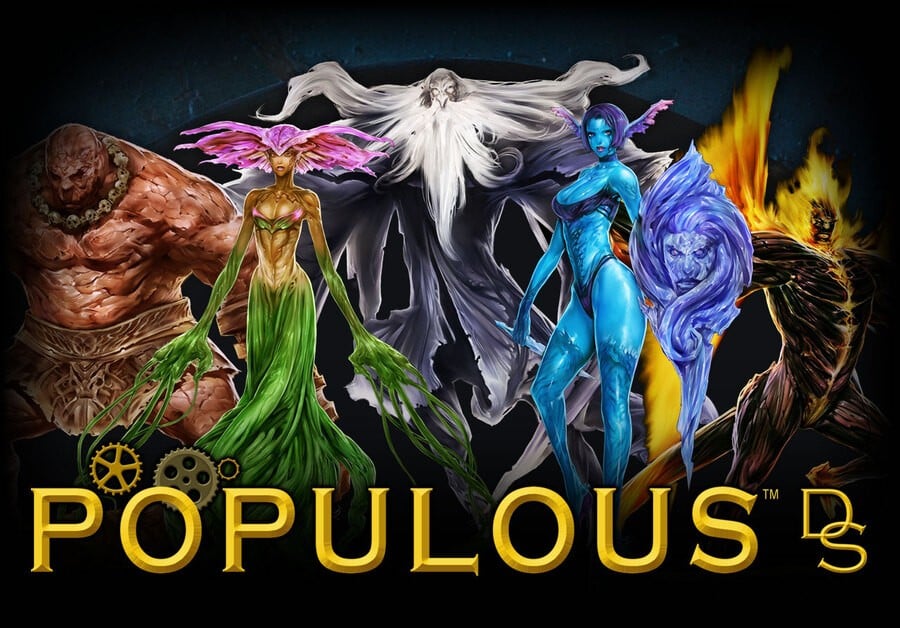
PowerMonger was initially pitched as being an evolution of Populous; while it lacked the 'God Sim' aspect and was more tactical in nature, it promised a living, breathing world in which each character would have allegiances and even memories, so your actions could potentially come back to haunt you. The game was fantastic, but much of the truly groundbreaking stuff that the infectiously affable Molyneux spoke about in early interviews ended up hitting the cutting room floor, and the designer has struggled to shake off this reputation of over-promising ever since. It's at this point in our discussion that he dips into his seemingly bottomless collection of wonderful anecdotes to pull out a tale that you could argue goes some way to explaining why, as a developer, he has always bravely aimed for the stars – even when the goal is clearly unobtainable.
"There were two big things about PowerMonger – the first is that it was started literally after Populous was launched. The next day, we started on PowerMonger. The second thing was an unfortunate event which happened about halfway through development. I went to this drinks thing which was organised by Gary Whitta, who is now a successful Hollywood scriptwriter with movies like Rogue One: A Star Wars Story and Book of Eli to his name. He was this cheeky kid of a journalist at the time, and he managed to bully me into this meeting between David Braben (Elite), Jez San (Starglider, Star Fox) and Archer Maclean (Dropzone) down the pub." You'd assume that Molyneux felt he was amongst equals, but that wasn't the case.
"These guys were the top of the games industry and hyper-intelligent human beings, and then there was me!" he laughs. "During that meeting down the pub, they were all talking about developing games – 6502 Assembly and x86 and all that advanced stuff – and I was just sitting in the corner, and said 'Well, actually my game was developed in C', and there was this stunned silence. I could just see them all just giggling and saying, 'That’s not a proper game developer!' So I went back to the office that afternoon, tanked up on several pints of bitter, and I threw all of the floppy discs which held the code in the bin and I taught myself Assembly. There was this incredible pressure to do that, and I did that only because I wanted to be one of the smart boys rather than a stupid kid in the class."
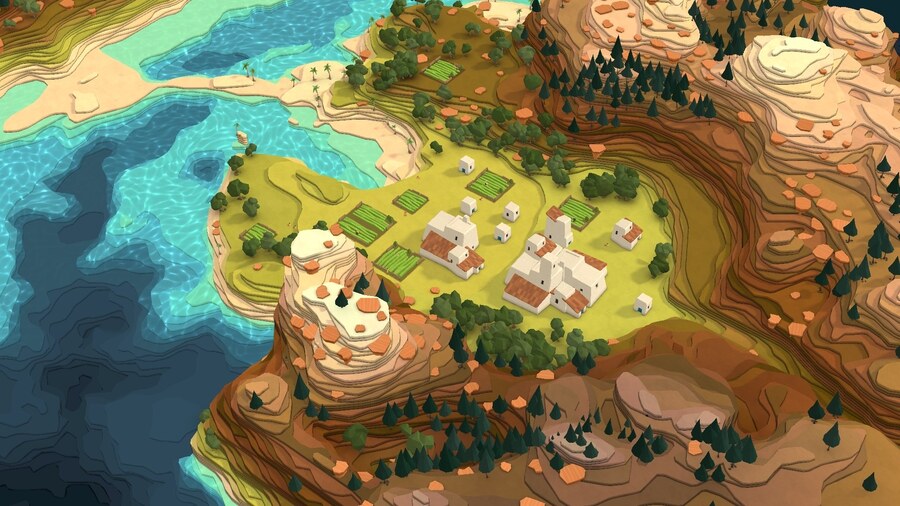
It might seem like hyperbole, but that fateful night in a Guildford pub had a transformative effect on the previously shy and retiring Molyneux, and came at a time when his company – and his life – were swept away in what must have felt like an uncontrollable tide of relentless progress. "I’d gone from being someone who rarely ventured away from my computer and barely socialised at all into doing all of this press and all of that stuff," he explains. "I’ll be honest, I don’t really remember the distinction between Populous, PowerMonger, or Populous II. We’re only talking about a span of two or so years. In that time, Bullfrog had to be expanded, we had to launch games in a variety of countries, we had to service Electronic Arts, and we had to author two new games. It was insane, and I don’t know how that worked."
But it did work, and since then, Molyneux's career has spanned several million-selling video games (including Theme Park, Dungeon Keeper, Syndicate, Black & White and Magic Carpet), the formation of a new company in the guise of now-defunct Lionhead, a lead role at Microsoft and – more recently – a return to humbler roots via 22cans, his current studio. Despite the whirlwind nature of his working life, Molyneux has an understandable soft spot for the game that made it all possible in the first place; 22cans' Godus is arguably a riff on Populous, but Molyneux feels there's ample room for a proper revival to take place (the series has been dormant since the release of the Genki-developed Populous DS in 2007).
"I think there's something innately interesting about allowing people to create a world and compete in creating a world, and I’d love to see someone explore that more," he says, and draws comparisons between his 1989 opus and Minecraft, a title which arguably offers some of the same appeal, albeit on a much grander scale. "I’m not even beginning to suggest that Populous stands anywhere near Minecraft, but what I would say is that Minecraft proves that there is this overwhelming interest in creating living worlds," he continues. "Rather than Populous being one tribe versus another tribe, think more about how sculpting a living world – which is the heart of Populous – could actually evolve. There were bits of Populous that I have, over my career, pulled out. Good versus Evil, for example. So I think there are some interesting things still to analyse about it; there are some fascinating things there."
Ultimately, while Molyneux no longer owns the Populous name, it remains a pivotal game in his career and it's obvious that even after all the subsequent games, fame and fortune, he still has a tremendous degree of affection for the title that made it all possible in the first place. "I had so much joy making that stuff, I can’t begin to tell you," he concludes. "For someone like me, who was kind of a nobody who had nothing, I was created by the games industry, and it’s just a joy to be involved in it – and it still is to this day."
This article was originally published by nintendolife.com on Sun 3rd February, 2019.






Comments 29
I thought Molyneux threw a hissy fit and vowed never to speak to the press again.
Brilliant story. Peter Molyneux was a real visionary in that era. Best version of Populous, though, is the one on the Master System. Weird, but true.
Polarizing individual. But a good read nonetheless. I also see nothing necessarily wrong in dreaming big. So for that, I’ve never understood the hate towards him. I will say Fable 2 remains one of my favorite experiences ever. So for that, I appreciate his creativity
My early 20’s should have been an alcohol fuelled haze. Thanks to the likes of Elite (1&2) and Syndicate, this was not the case.
I didn't realise he had done good things! I only knew his name from the disaster that was Godus, so at least he had a decent career in the past
I utterly love “Populous: The Beginning“ (1998) for Windows! But I don’t get why I’ve never seen it mentioned in articles about the Populous series.
My video rental store had a one hour return policy on games. If you didn't like it you could get an exchange for something else.
I rented Populous and didn't understand what was happening. I was just about to convince my mom to drive me back to the rental store when I decided to give it one more shot. For some reason it all suddenly made sense, and it hooked me. Once I got it, I loved it. It is still one of my fav snes games.
@Krull I had this on the master system and it was indeed brilliant.
No hate for the guy on a personal level, I just think he gets over his head, making too many promises and not delivering.
Curiously I was playing this just this morning.
This is the kind of article I love to read.
Lovely story! By Peter Molyneux so at least half of it is true?
Molyneux has some sort of God complex. The industry is better without him.
I still have a soft spot for Molyneux's games, and many fond memories of them. Theme Park, Theme Hospital, Dungeon Keeper, even Gene Wars, for as flawed and unfulfilling of its potential as that game was.
This past handful of years, no less than four separate wannabes of Theme Hospital have caught my attention, and a very deliberate Dungeon Keeper knock-off has reared its head as well. Clearly a lot of developers still look up to Molyneux.
@Krull
Strangely, that is the version I own.
It was apparently rebuilt ground-up by the guys at TecMagik, another small UK studio.
Populous was highly addictive back in the day.
Is this a Larry Bundy Jr reference? lol
Nice article! I never played populus back then, but seeing 2 people pulling of this much attention with one game and seeing how many people work on one game today and are far less successful is very astonishing! Somehow the Concerned Ape reminds me of that
did he promise more than he could deliver? because thats usually how he gets people. and somehow they still havent learned to this day to stop listening to him.
@WinterIceFox Ninja'd me there. We need to alert him.
I think the craziest thing not mentioned in this article is that Populous even had a Game Boy port. It must have been the clunkiest, muddiest thing.
@SmaggTheSmug It basically came out on everything.
Hill simulator would have been a better name for this, as that's all I can seem to remember having to do all the time - raise and lower hills. Still, fascinating article though.
I only ever played Populous 3 and had no idea about its history. I was absolutely addicted to it when it launched on PC and would kill for a full-blown sequel.
@companyoflosers that's how I got my job though. It's a proven tactic!
It's a cool story, back from when Molyneaux was really a master game designer.
The one common thread from this story, and the ill fated departure from EA, etc, however, is, Mr. Molyneaux seems to have a bit of a drinking problem...and it's gotten him in trouble many times....
Brilliant read, thanks for that article. Don't think ive played populous since my mate's Amiga in the early 90s but i remember it being a great game, very different from anything else at the time (then we discovered Settlers and that took over!)
On another note, slightly depressing to see the number of comments on a well written, original and interesting article like this vs throwaway 'what do you think of this rumour' piece. I mean, human nature and all I guess, but when people complain about clickbait and recycled journalism, it's not hard to see why things are the way they are. Website's gotta make money, writers gotta eat.
Still, appreciate the work that goes into a piece like this. Cheers @Damo !
@MischiefMaker Thanks for the feedback. Like you, I have noticed that the 'usual suspects' who clog up every other post we do with accusations of 'clickbait' are curiously absent whenever we publish something like this, which takes days of planning and work to bring together. We certainly won't stop doing pieces like this; I feel it's a unique service that other Nintendo sites don't offer at the moment.
Great article which I missed first time around. A well written piece.
Explains why this has been added into the megadrive mini 2 line up; I hadn’t realised it was so big in Japan.
Show Comments
Leave A Comment
Hold on there, you need to login to post a comment...